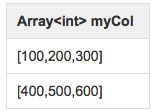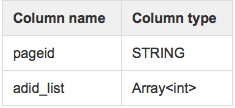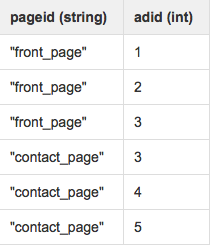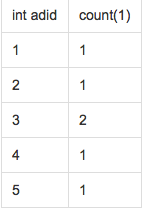1.explode
hive wiki对于expolde的解释如下:
explode() takes in an array (or a map) as an input and outputs the elements of the array (map) as separate rows. UDTFs can be used in the SELECT expression list and as a part of LATERAL VIEW.
As an example of using explode() in the SELECT expression list, consider a table named myTable that has a single column (myCol) and two rows:
Then running the query:
SELECT explode(myCol) AS myNewCol FROM myTable;
will produce:
The usage with Maps is similar:
SELECT explode(myMap) AS (myMapKey, myMapValue) FROM myMapTable;
总结起来一句话:explode就是将hive一行中复杂的array或者map结构拆分成多行。
使用实例:
xxx表中有一个字段mvt为string类型,数据格式如下:
[{“eid”:”38”,”ex”:”affirm_time_Android”,”val”:”1”,”vid”:”31”,”vr”:”var1”},{“eid”:”42”,”ex”:”new_comment_Android”,”val”:”1”,”vid”:”34”,”vr”:”var1”},{“eid”:”40”,”ex”:”new_rpname_Android”,”val”:”1”,”vid”:”1”,”vr”:”var1”},{“eid”:”19”,”ex”:”hotellistlpage_Android”,”val”:”1”,”vid”:”1”,”vr”:”var01”},{“eid”:”29”,”ex”:”bookhotelpage_Android”,”val”:”0”,”vid”:”1”,”vr”:”var01”},{“eid”:”17”,”ex”:”trainMode_Android”,”val”:”1”,”vid”:”1”,”vr”:”mode_Android”},{“eid”:”44”,”ex”:”ihotelList_Android”,”val”:”1”,”vid”:”36”,”vr”:”var1”},{“eid”:”47”,”ex”:”ihotelDetail_Android”,”val”:”0”,”vid”:”38”,”vr”:”var1”}]
用explode小试牛刀一下:
elect explode(split(regexp_replace(mvt,'\\[|\\]',''),'\\},\\{')) from ods_mvt_hourly where day=20160710 limit 10;
最后出来的结果如下:、
{“eid”:”38”,”ex”:”affirm_time_Android”,”val”:”1”,”vid”:”31”,”vr”:”var1”
“eid”:”42”,”ex”:”new_comment_Android”,”val”:”1”,”vid”:”34”,”vr”:”var1”
“eid”:”40”,”ex”:”new_rpname_Android”,”val”:”1”,”vid”:”1”,”vr”:”var1”
“eid”:”19”,”ex”:”hotellistlpage_Android”,”val”:”1”,”vid”:”1”,”vr”:”var01”
“eid”:”29”,”ex”:”bookhotelpage_Android”,”val”:”0”,”vid”:”1”,”vr”:”var01”
“eid”:”17”,”ex”:”trainMode_Android”,”val”:”1”,”vid”:”1”,”vr”:”mode_Android”
“eid”:”44”,”ex”:”ihotelList_Android”,”val”:”1”,”vid”:”36”,”vr”:”var1”
“eid”:”47”,”ex”:”ihotelDetail_Android”,”val”:”0”,”vid”:”38”,”vr”:”var1”}
{“eid”:”38”,”ex”:”affirm_time_Android”,”val”:”1”,”vid”:”31”,”vr”:”var1”
“eid”:”42”,”ex”:”new_comment_Android”,”val”:”1”,”vid”:”34”,”vr”:”var1”
2.lateral view
hive wiki 上的解释如下:
Lateral View Syntax
lateralView: LATERAL VIEW udtf(expression) tableAlias AS columnAlias (‘,’ columnAlias)*
fromClause: FROM baseTable (lateralView)*
Description
Lateral view is used in conjunction with user-defined table generating functions such as explode(). As mentioned in Built-in Table-Generating Functions, a UDTF generates zero or more output rows for each input row. A lateral view first applies the UDTF to each row of base table and then joins resulting output rows to the input rows to form a virtual table having the supplied table alias.
Example
Consider the following base table named pageAds. It has two columns: pageid (name of the page) and adid_list (an array of ads appearing on the page)
An example table with two rows:
and the user would like to count the total number of times an ad appears across all pages.
A lateral view with explode() can be used to convert adid_list into separate rows using the query:
SELECT pageid, adid
FROM pageAds LATERAL VIEW explode(adid_list) adTable AS adid;
The resulting output will be
Then in order to count the number of times a particular ad appears, count/group by can be used:
SELECT adid, count(1)
FROM pageAds LATERAL VIEW explode(adid_list) adTable AS adid
GROUP BY adid;
The resulting output will be
由此可见,lateral view与explode等udtf就是天生好搭档,explode将复杂结构一行拆成多行,然后再用lateral view做各种聚合。
3.实例
还是第一部分的例子,上面我们explode出来以后的数据,不是标准的json格式,我们通过lateral view与explode组合解析出标准的json格式数据:
SELECT ecrd, CASE WHEN instr(mvtstr,'{')=0
AND instr(mvtstr,'}')=0 THEN concat('{',mvtstr,'}') WHEN instr(mvtstr,'{')=0
AND instr(mvtstr,'}')>0 THEN concat('{',mvtstr) WHEN instr(mvtstr,'}')=0
AND instr(mvtstr,'{')>0 THEN concat(mvtstr,'}') ELSE mvtstr END AS mvt
FROM ods.ods_mvt_hourly LATERAL VIEW explode(split(regexp_replace(mvt,'\\[|\\]',''),'\\},\\{')) addTable AS mvtstr
WHERE DAY='20160710' and ecrd is not null limit 10
查询出来的结果:
xxx
{“eid”:”38”,”ex”:”affirm_time_Android”,”val”:”1”,”vid”:”31”,”vr”:”var1”}
xxx
{“eid”:”42”,”ex”:”new_comment_Android”,”val”:”1”,”vid”:”34”,”vr”:”var1”}
xxx
{“eid”:”40”,”ex”:”new_rpname_Android”,”val”:”1”,”vid”:”1”,”vr”:”var1”}
xxx
{“eid”:”19”,”ex”:”hotellistlpage_Android”,”val”:”1”,”vid”:”1”,”vr”:”var01”}
xxx
{“eid”:”29”,”ex”:”bookhotelpage_Android”,”val”:”0”,”vid”:”1”,”vr”:”var01”
xxx
{“eid”:”17”,”ex”:”trainMode_Android”,”val”:”1”,”vid”:”1”,”vr”:”mode_Android”}
xxx
{“eid”:”44”,”ex”:”ihotelList_Android”,”val”:”1”,”vid”:”36”,”vr”:”var1”}
xxx
{“eid”:”47”,”ex”:”ihotelDetail_Android”,”val”:”1”,”vid”:”38”,”vr”:”var1”}
xxx
{“eid”:”38”,”ex”:”affirm_time_Android”,”val”:”1”,”vid”:”31”,”vr”:”var1”}
xxx
{“eid”:”42”,”ex”:”new_comment_Android”,”val”:”1”,”vid”:”34”,”vr”:”var1”}
4.Ending
Lateral View通常和UDTF一起出现,为了解决UDTF不允许在select字段的问题。
Multiple Lateral View可以实现类似笛卡尔乘积。
Outer关键字可以把不输出的UDTF的空结果,输出成NULL,防止丢失数据。
参考内容:
1.http://blog.csdn.net/oopsoom/article/details/26001307 lateral view的用法实例
2.https://my.oschina.net/leejun2005/blog/120463 复合函数的用法,比较详细
3.http://blog.csdn.net/zhaoli081223/article/details/46637517 udtf的介绍
---------------------
作者:bitcarmanlee
来源:CSDN
原文:https://blog.csdn.net/bitcarmanlee/article/details/51926530









发表评论:
◎欢迎参与讨论,请在这里发表您的看法、交流您的观点。